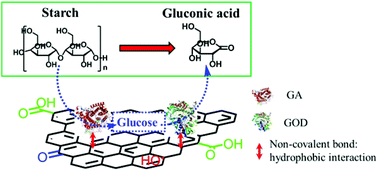Co-immobilization of multi-enzyme on control-reduced graphene oxide by non-covalent bonds: an artificial biocatalytic system for the one-pot production of gluconic acid from starch†
Abstract
Here we report a simple and efficient approach to fabricate a new biocatalytic system by co-immobilizing multi-enzyme on chemically reduced graphene oxide (CRGO) via non-covalent bonds. The obtained artificial biocatalyst was characterized by UV/Vis, FTIR, AFM, TEM and SEM. Compared with native and graphene oxide (GO) bounded enzymes, it was found that the glucose oxidase (GOD) or glucoamylase (GA) immobilized on CRGO exhibited significantly higher enzymatic activity, due to the positive effect of the CRGO carrier. This multi-enzyme microsystem was employed as a biocatalyst to accomplish the starch-to-gluconic acid reaction in one pot, and the yield of gluconic acid could reach 82% within 2 hours. It was also proved that the stability of the multi-enzyme biocatalyst immobilized on CRGO was dramatically enhanced compared with the GO microsystem. About 85% of the activity of the artificial biocatalyst could be preserved after four cycles. These results demonstrated the feasibility of the novel strategy to construct bio-microsystems with multi-enzyme on 2D CRGO via non-covalent bonds to accomplish some complex conversions.


 Please wait while we load your content...
Please wait while we load your content...